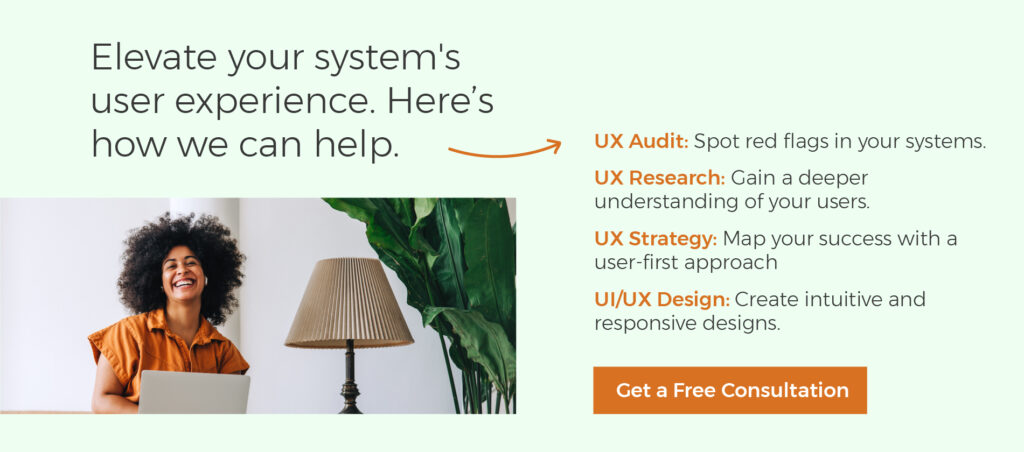User UX research is paramount when it comes to creating a rich and valuable user experience. Done right, it also translates into a product that’s high on quality, utility, as well as business returns.
The enterprise context brings with it its unique set of challenges – a large number of stakeholders, legacy systems, and buyers who aren’t necessarily users – to name a few. Therefore, certain key pointers must be kept in mind while conducting UX research while designing enterprise software.
Enterprise buyers aren’t its actual users
An enterprise application vastly differs from a regular B2C app, considering that the customer is never your actual user. A company develops its applications for its employees – and is seen as a means to achieve business goals.
Users of enterprise applications function with a sense of compulsion, rather than choice, because their job requires them to do so. Thus, understanding their needs and fulfilling their requirements is vital. Failure in this space results in high levels of resentment which negatively impacts performance. The success of the enterprise project rests heavily on how well the user needs are fulfilled, which leads to enhanced productivity. However, fulfilling user needs begins with the accuracy and finesse employed by the research team at the very beginning.
Multiple personas using a common workflow
Enterprise systems are handled by users with different functions, expertise levels, and positions of authority. Each individual user has his own functionality embedded into the system which connects him with other users in the workflow. Within the system, every job function may have its own interfaces, utilities, and functions. Most workflows may process varied sequences of actions carried by different sets of users.
It is the researcher’s responsibility to cover all protocols connecting the users of the workflow. Also, asking pressing questions that reveal the connecting actions between teams is essential to understand the details of internal communication and mutual dependencies.

Gain a basic understanding of the domain with UX Research
Enterprise applications comprise an intricate weave of complex interfaces and interactions that help drive the business forward on a day-to-day basis. Thus, a deep understanding of the workflows is an absolute requirement for any research team. This process involves ensuring that the needs of each user role match up well with each task along the workflow.
It goes without saying that working on enterprise projects calls for obtaining a thorough insight of the domain within which the application is being used. An advantage here is that researchers can seek out the users, who are the real experts in terms of using the application as well as possess domain-related inside information. The onus lies on the researcher to create a well-functioning working relationship with the users in order to solicit the right information, interpret it, and thoughtfully connect the dots.
Armed with the basic domain knowledge, you will be in a better position to map and analyze your findings in a meaningful manner.
User behavior is as complex as the legacy system they work with
The majority of users working with legacy systems do so solely to accomplish their duties, no questions asked. There are several instances of people learning selected parts of the mainframe that are needed to complete their job. Any minor change in the workflow may result in a drop in efficiency since they refrain from understanding the functionality of the system as a whole. From the designers’ perspective, this kind of user behavior can bring in an element of reluctance while introducing changes in the system.
Thus, the researchers have to also carefully study the history of the system, its evolution, and user reactions to it, in addition to understanding the current behavior patterns and expectations from a new system.
What users say vs. what they actually do
In UX research, you cannot take anything at face value. As a researcher, you’d want to trust people when they express their thoughts and feelings in interviews and feedback forms, but you also have to rely on your instincts to get to the bottom of things. Working in such an environment requires you to cross-check and analyze the obtained data and verify it against multiple scenarios. Furthermore, you also keep abreast of other decision-influencing factors such as the work dynamics, hierarchy, and cultural issues, especially within large organizations. As overwhelming as it may sound, this indeed is an essential aspect of EUX research. It helps, greatly, to pay attention and observe things that simplify complicated workflows like places where people need help in navigation or spots where they seek proactive suggestions and appropriate hints for navigating to external systems.
User delight in enterprise systems is possible
Surprised? You shouldn’t be. After all, users – be it enterprise or consumers – are human. It’s just that the years of mental conditioning has led them to believe that dull and complex enterprise applications are bitter, yet the necessary reality of their work life. These very people are easily able to diss bad experiences in commercial apps, but when they transform into being an enterprise user, any minor change that improves their workflow makes them jump with joy. During the product testing phase, designers may often encounter instances of users expressing immense delight at the smallest of changes which makes their job even a tad easier.
Needless to say, that all users are human after all, and they bear a common desire to work with delightful and pleasurable systems that are aligned with real-world experiences.
For the designer, working in enterprise systems may feel akin to walking in a field infested with landmines. However, the success gained in working on such projects is also as sweeter, if not more. The rate of this success hinges greatly on the quality of the findings and observations derived by the research teams – after all, this is the step where the great EUX revolution actually begins.










